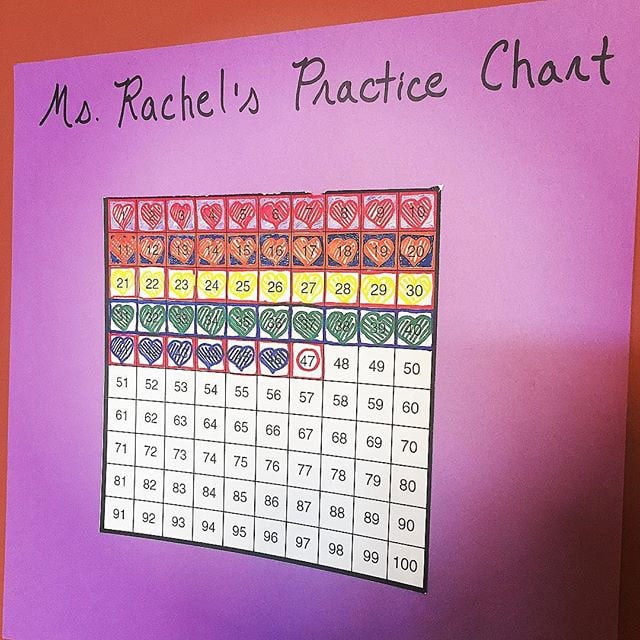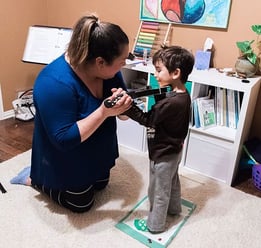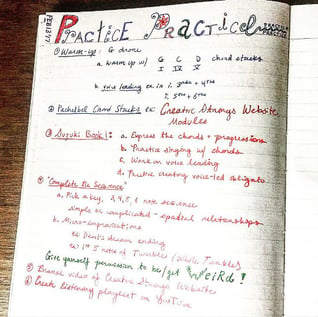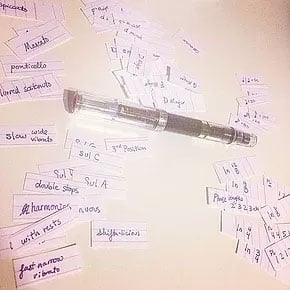 Are you the parent of a young string player? This blog will really help YOU with your child's practice. Rachel Samson is a Suzuki viola/violin teacher in Frisco Texas. She and her husband Neil Fong Gilfillan (cello) run Chili Dog Strings, the only string studio in Frisco named after a dog. SHAR is happy to have their permission to share two blogs originally posted on their strings studio blog page, Think Like A Gamer: Power Up Your String Player Stats, by Neil Fong Gilfillan, and High Definition for the Practicing Parent, by Rachel Samson. Both of these blogs highlight the importance of parents and teachers reaching out at the level of the student to set goals that are both manageable and motivational.
Are you the parent of a young string player? This blog will really help YOU with your child's practice. Rachel Samson is a Suzuki viola/violin teacher in Frisco Texas. She and her husband Neil Fong Gilfillan (cello) run Chili Dog Strings, the only string studio in Frisco named after a dog. SHAR is happy to have their permission to share two blogs originally posted on their strings studio blog page, Think Like A Gamer: Power Up Your String Player Stats, by Neil Fong Gilfillan, and High Definition for the Practicing Parent, by Rachel Samson. Both of these blogs highlight the importance of parents and teachers reaching out at the level of the student to set goals that are both manageable and motivational.
Ever feel like you're only getting a fraction of the work done at home that your teacher outlines in the lesson? Sometimes the “How” of home practice is somewhat of a mystery, or at the very least, unclear. Let’s explore how to give your practice more clarity and definition to keep you on track with your teacher’s assignments and your child’s accomplishments.
Here are 6 steps that, when followed, can get you on track to step up your home practice and magnify your results.
1. Make a list of all the activities you could do in this session.
What are the specific tasks your teacher asked you to do? This could include active listening, hitting a certain review, working on specific goals mentioned and outlined by your teacher in the lesson, new material being learned, “by ear” work, preparation for a performance, or any other tasks requested or specified by teacher. Is there anything extra that you and your child want to cover?
Some of the foundational skills will always be in place. Some days you may need to revisit focus on certain skills, like say, focus or all candy cane fingers or a bent thumb in the bow hold. Some days you may be working on a technique that serves to unlock a new piece. Some days you may be plugging away at the long-term development of a skill, such as vibrato or note reading. Make sure you have a clear understanding of what skills your teacher is working to develop in your child. If you’re unsure, ask!
Some days you may be working on a technique that serves to unlock a new piece. Some days you may be plugging away at the long-term development of a skill, such as vibrato or note reading. Make sure you have a clear understanding of what skills your teacher is working to develop in your child. If you’re unsure, ask!
2. Make a list of all the obstacles.
Think of all the things that could get in your way of a successful practice session that day. Time constraints, irritability from lack of rest, illness, focus issues, or other personal issues your child is dealing with. Don't get slowed down by problems, just take note of them and keep moving.
One of Dr. Suzuki's strongest calls to action is to regularly and honestly reflect on yourself to contemplate how you are contributing to your child's development. Do you ever project a negative attitude when it's time to practice, causing them to resist even more? Are you providing the kind of environment for your child that encourages the right behavior, making your job easier when it's time to act? Thoughts like “My child just doesn’t want to learn from me” or “My child insists on being difficult” can lead towards an investigation of your child's reactions and why they're set up to behave like that. What variables in this equation could you change to see if the results get better?
3. Make a list of people whose cooperation and support you will need in order to succeed.
 Your Self. Your child. Your teacher. Your partner or spouse. Your other children or pets--any other family members or friends who lend support in your family unit.
Your Self. Your child. Your teacher. Your partner or spouse. Your other children or pets--any other family members or friends who lend support in your family unit.  Maybe that looks like your spouse watching the newborn for 20 minutes, or utilizing a sibling's playdate as practice time for your child's practice. By taking full advantage of the support that’s available and needed, you increase your chances of building and carrying out a successful practice.
Maybe that looks like your spouse watching the newborn for 20 minutes, or utilizing a sibling's playdate as practice time for your child's practice. By taking full advantage of the support that’s available and needed, you increase your chances of building and carrying out a successful practice.
4. Make a list of all the actions that need to be taken in order for practice to occur today.
Schedule a time. Prepare your child for the practice session-- put it on his or her radar. Make sure everyone is fed, watered, and has a chance to use the bathroom. Make sure everyone is alert and ready to learn. Be ready to remain present and focused on the practice session. Use support from list #3 as needed.
5. Make a list of priorities.
 Has your teacher emphasized a certain goal? Is there something he or she wants you to do above and before any other activity? Prioritize it. After that, figure out what is a priority to you and your child. If your kiddo really likes to groove and move, maybe you need to prioritize some unadulterated playing time. If you really enjoy working repetitions with your child, find the foundational or skill-building goals that are going to give you some time together strengthening those neuro pathways in the brain.
Has your teacher emphasized a certain goal? Is there something he or she wants you to do above and before any other activity? Prioritize it. After that, figure out what is a priority to you and your child. If your kiddo really likes to groove and move, maybe you need to prioritize some unadulterated playing time. If you really enjoy working repetitions with your child, find the foundational or skill-building goals that are going to give you some time together strengthening those neuro pathways in the brain.
Perhaps your priority looks more like a time-crunch accommodation. Maybe your priority is getting in multiple one-point or one-activity lessons in one day. Remember, three tiny successful practices can be way more effective than one long miserable one. Or perhaps your priority looks like no meltdowns or bad attitudes (from either party) in the home practice. Develop strategies to make this happen-- more on this in a future post.
Often, studio parents will fill us in on their practice week like this: “We did x, y, z, and then, because we felt like it, we made a little game…” or “She loved her review so much this week, she wanted to color a picture based on how each piece made her feel!” or “At the very ends of our practice, we carved out time to make up music and jam on some improv!” etc. One of my greatest joys as a teacher is when I see how the lessons I teach create opportunities for children and parents to build something together with their own flair!
Your ideas are ready for action!
Now, Take Action!
Now not only do you have a model of home practice based off of your teacher's lesson structure, you also have a personalized lesson plan that's specialized for you and your child to maximize your unique situation and strengths. Take action, write down your results, see what's most useful, and be prepared to adapt as you both continue to grow and be a more effective team.
Today’s lists were inspired by an excerpt of Brian Tracy’s No Excuses!: The Power of Self-Discipline.
 Rachel Samson is passionate about applying the legacy of Shinichi Suzuki in her teaching, and strives to deliver to parents the necessary tools to help their children succeed. Rachel and her husband Neil Fong Gilfillan operate Chili Dog Strings in Frisco TX. You can find them on Youtube, Instagram, and Facebook! We are featuring this blog with their permission as part of a SHAR Guest Blog series. For more guest author blogs, staff writer blogs, tips, announcements, and product reviews, be sure to subscribe to the SHAR Blog!
Rachel Samson is passionate about applying the legacy of Shinichi Suzuki in her teaching, and strives to deliver to parents the necessary tools to help their children succeed. Rachel and her husband Neil Fong Gilfillan operate Chili Dog Strings in Frisco TX. You can find them on Youtube, Instagram, and Facebook! We are featuring this blog with their permission as part of a SHAR Guest Blog series. For more guest author blogs, staff writer blogs, tips, announcements, and product reviews, be sure to subscribe to the SHAR Blog!



